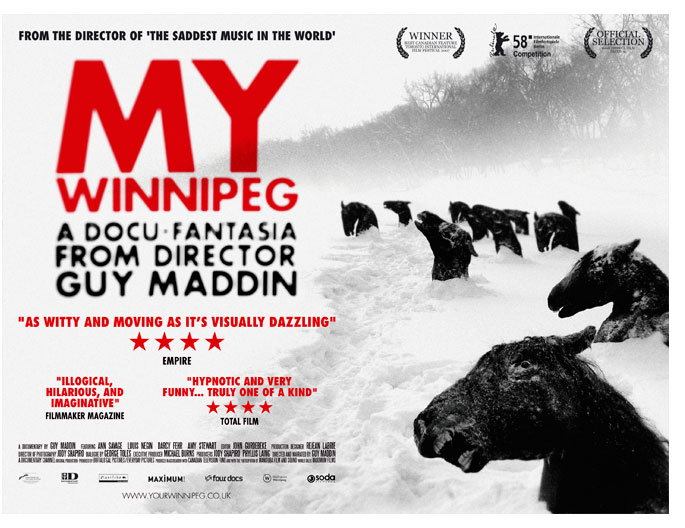by Alex Fitch
Electric Sheep Magazine

Close to the geographical centre of the North American continent is the seventh largest Canadian city – although the locals consider it relatively small – Winnipeg, in the province of Manitoba. Native Americans first arrived in the area 6000 years ago, Europeans in 1738 and it was incorporated as a city in 1873.
Although Guy Maddin’s new film My Winnipeg may provide their first introduction to the place to most British viewers (beyond Homer Simpson using it as his base in the episode where he becomes a prescription drug mule and A.A. Milne’s confusion over the origin of Winnie-the-Pooh), film has been used as a promotional tool for the location for almost as long as cinema has been in existence. In 1888, James Freer, a reporter from Bristol, emigrated to the city and became Canada’s first filmmaker plus a keen proponent of his new home to boot, shipping the pro-emigration film Ten years in Manitoba back to his country of birth in 1898. 120 years later, Manitoba’s most illustrious filmmaker (if that isn’t damning him with faint praise) is still using the techniques of silent cinema and has made, if not a love letter to his home, at least a salacious biography that might equally be called Fifty-two years in Manitoba and everything that intrigues me about the half-century before…
Guy Maddin has always been a curious filmmaker, in all the connotations of the word, creating films that take an oblique look at their subject matter and often seem impenetrable to the casual observer. What makes Maddin’s directorial style most recognisable is his appropriation of the language of silent movies; even though many of his films contain some synch sound and dialogue, the use of inter-titles, lower frame rates (than the modern minimum of 24 fps), monochrome / tinted cinematography and degraded film stock make them look more cognate to the cinema of a hundred years ago than to modern filmmaking. In a climate of slick CGI, $100-million-budgets and a fixation on verisimilitude, Maddin’s faux retro style makes his films stand out as some of the most intriguing, exciting and unique in today’s cinema.
Two recent films brought his work to the attention of British audiences, Dracula: Pages from a Virgin’s Diary and The Saddest Music in the World, both of which had an angle that made them more approachable to audiences unaccustomed to seeing silent-style movies. Dracula is a filmed version of the Royal Winnipeg ballet; it premiered first on the BBC before transferring to cinemas (perhaps to gauge the audience) and arrived on the big screen not long after a similar production at Sadler’s Wells. The Saddest Music in the World is a musical (which the British seem to love) and has a bankable star in the form of Isabella Rossellini. In contrast, Cowards Bend the Knee and Brand upon the Brain! which Maddin made either side of The Saddest Music, only received festival screenings in this country; perhaps the subject matter – the sexuality of ice hockey players and incest in a remote lighthouse respectively – was considered too outré, especially when combined with his idiosyncratic style.
To Read the Rest of the Essay

No comments:
Post a Comment